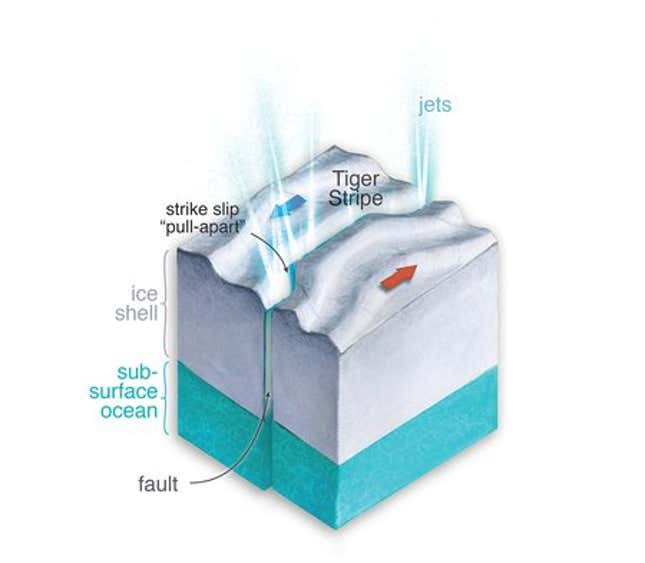Jostling on the fault lines of Enceladus’ frozen crust may be responsible for the plumes of icy material spewing from the moon’s watery underbelly, according to a team of researchers that recently modeled the motion.
The team’s study focused on Enceladus’ “tiger stripes”—long fissures mostly located in southern swaths of the moon that some thought were caused by an ancient impact event. Other researchers concluded that Enceladus’ irregular orbit was responsible; the moon arcs far from Saturn and back again, causing the planet’s gravitational pull to deform the moon with tidal stresses, warming its interior. Now, a different team characterized the motion of the tiger-stripe faults in a computer model and found new details of how the moon’s jets occur. Their findings were published this week in Nature Geoscience.

“We hypothesize that strike-slip motion can extend transtensional bends (for example, pull-apart structures) along geometric irregularities over the tiger stripes and thus modulate jet activity,” the researchers wrote in the study. In other words, the strike-slip, sideways motion on the moon’s tiger stripes contribute to the moon’s occasional spurts.
Enceladus is an object of particular intrigue for scientists because of the salty water ocean scientists believe lies beneath the moon’s icy crust. Water is essential for life as we know it, and researchers can get glimpses of Enceladus’ ocean through the plumes of icy material ejected by the moon through evident cracks in its shell. Last year, astrobiological hopes for Enceladus were boosted by the confirmation of phosphorus, a building block of life, in the plumes; just a few months ago, data from the Cassini spacecraft confirmed evidence of hydrogen cyanide—another life ingredient—being belched up by the moon.
Enceladus’ south pole plume produces two peaks over the course of the moon’s 33-hour orbit. One theory was that the tiger-stripe faults open and close, allowing varying amounts of material to escape the moon. But according to a Caltech release, that mechanism takes more energy than scientists expect is available from the tidal pull on Enceladus. The recent team’s model offered a different theory: plume’s strength may vary in intensity due to a “strike-slip” motion, by which the faults shear past one another, creating gaps (or “pull-aparts”) in the faults that allow the jets to escape.
“We now have the capacity to image fault slip, such as earthquakes, on Earth using radar measurements from satellites in orbit,” said Alexander Berne, a graduate student at Caltech and the study’s lead author, in an institute release. “Applying these methods at Enceladus should allow us to better understand the transport of material from the ocean to the surface, the thickness of the ice crust, and the long-term conditions which may enable life to form and evolve on Enceladus.”
Enceladus is probably the most promising candidate for a life-hosting body in our solar system—besides Earth, of course—and study by study, we get closer to understanding what that life might look like, and how we may get a glimpse of it.
More: Experiment Shows Microbes Could Thrive on Saturn’s Moon Enceladus




















+ There are no comments
Add yours